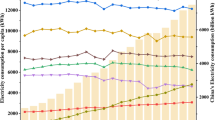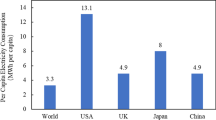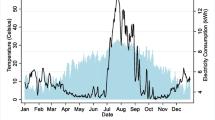Abstract
Intensifying climate change significantly impacts residential electricity consumption, especially in developing countries, such as China, that are experiencing rapid income growth. By combining meteorological and monthly household consumption survey data, this study explores the response function of residential electricity consumption to temperature in China from a micro perspective. Future residential electricity demands and related CO2 emissions are then forecast under different climate scenarios. Overall, the response function is U-shaped, and one additional day above 34 °C will increase monthly residential electricity consumption by 2.11%. Global warming will more likely increase the electricity burden on low-income groups. There will be notable seasonal changes in electricity demand in the future, and the largest increase will occur in August. The total demand for residential electricity caused by temperature change will show a fluctuating growth trend, from 0.8% and 1% in 2025 to 2% and 2.9% in 2060 under the RCP4.5 scenario and RCP8.5 scenario, respectively; meanwhile, this demand will be accompanied by a cumulative increase in carbon dioxide emissions.









Similar content being viewed by others
Data availability
The data that support the plots within this paper is available from the corresponding author upon reasonable request.
Code availability
The codes that support the methods of this study are available from the corresponding author upon reasonable request.
Notes
In contrast to developed countries, in China, the economic reform of the energy market has not been adequate, and electricity prices are still controlled by the government. In 2013, the step tariff system was gradually implemented in all provinces. In this study, the electricity price control variable relies on the electricity price in the different regions and periods corresponding to 300 kWh, which is the most frequent value encountered in electricity consumption data and can represent not only the electricity price faced by most households but also the step-change in electricity price.
References
Auffhammer M, Aroonruengsawat A (2011) Simulating the impacts of climate change, prices and population on California’s residential electricity consumption. Clim Chang 109(1):191–210. https://doi.org/10.1007/s10584-011-0299-y
Auffhammer M, Aroonruengsawat A (2012) Hotspots of climate-driven increases in residential electricity demand: a simulation exercise based on household level billing data for California. California Energy Commission, California
Auffhammer M, Mansur ET (2014) Measuring climatic impacts on energy consumption: a review of the empirical literature. Energy Econ 46:522–530. https://doi.org/10.1016/j.eneco.2014.04.017
Auffhammer M, Baylis P, Hausman CH (2017) Climate change is projected to have severe impacts on the frequency and intensity of peak electricity demand across the United States. P Natl Acad Sci USA 114(8):1886–1891. https://doi.org/10.1073/pnas.1613193114
Baxter LW, Calandri K (1992) Global warming and electricity demand: a study of California. Energ Policy 20(3):233–244. https://doi.org/10.1016/0301-4215(92)90081-c
Berkouwer SB (2020) Electric heating and the effects of temperature on household electricity consumption in South Africa. Energy J 41(4):209–230. https://doi.org/10.5547/01956574.41.4.sber
Bin S, Dowlatabadi H (2005) Consumer lifestyle approach to US energy use and the related CO2 emissions. Energ Policy 33(2):197–208. https://doi.org/10.1016/S0301-4215(03)00210-6
Blázquez L, Boogen N, Filippini M (2013) Residential electricity demand in Spain: new empirical evidence using aggregate data. Energy Econ 36:648–657. https://doi.org/10.1016/j.eneco.2012.11.010
Cao J, Ho MS, Li YT, Newell RG, Pizer WA (2019) Chinese residential electricity consumption: estimation and forecast using micro-data. Resour Energy Econ 56:6–27. https://doi.org/10.1016/j.reseneeco.2017.10.003
Chen YF, Zhao D, Shen JH (2018) Consumption response to the final mortgage payment: evidence from urban China. SSRN Electron J. https://doi.org/10.2139/ssrn.3298463
Chen X, Tan CM, Zhang XB, Zhang X (2020) The effects of prenatal exposure to temperature extremes on birth outcomes: the case of China. J Popul Econ 33(4):1263–1302. https://doi.org/10.1007/s00148-020-00768-4
Davis LW, Gertler PJ (2015) Contribution of air conditioning adoption to future energy use under global warming. P Natl Acad Sci USA 112(19):5962–5967. https://doi.org/10.1073/pnas.1423558112
Demetriou E, Hadjistassou C (2021) Can China decarbonize its electricity sector? Energ Policy 148:111917. https://doi.org/10.1016/j.enpol.2020.111917
Deschênes O, Greenstone M (2011) Climate change, mortality, and adaptation: evidence from annual fluctuations in weather in the US. Am Econ J Appl Econ 3(4):152–185. https://doi.org/10.1257/app.3.4.152
Du KR, Yu Y, Wei C (2020) Climatic impact on China’s residential electricity consumption: does the income level matter? China Econ Rev 63:101520. https://doi.org/10.1016/j.chieco.2020.101520
Eskeland G, Mideksa T (2009) Climate change and residential electricity demand in Europe. SSRN Electron J. https://doi.org/10.2139/ssrn.1338835
Fan JL, Hu JW, Zhang X (2019) Impacts of climate change on electricity demand in China: an empirical estimation based on panel data. Energy 170:880–888. https://doi.org/10.1016/j.energy.2018.12.044
Fan JL, Zeng B, Hu JW, Zhang X, Wang H (2020) The impact of climate change on residential energy consumption in urban and rural divided southern and northern China. Environ Geochem Hlth 42(3):969–985. https://doi.org/10.1007/s10653-019-00430-3
Franco G, Sanstad AH (2008) Climate change and electricity demand in California. Clim Chang 87(1):139–151. https://doi.org/10.1007/s10584-007-9364-y
Gao JB, Liu LL, Wu SH (2020) Hazards of extreme events in China under different global warming targets. Big Earth Data 4(2):153–174. https://doi.org/10.1080/20964471.2020.1769254
Guan YR, Shan YL, Huang Q, Chen HL, Wang D, Hubacek K (2021) Assessment to China's recent emission pattern shifts. Earth’s Future 9(11):e2021EF002241. https://doi.org/10.1029/2021EF002241
Hashimoto Y, Ohashi Y, Nabeshima M, Shigeta Y, Kikegawa Y, Ihara T (2019) Sensitivity of electricity consumption to air temperature, air humidity and solar radiation at the city-block scale in Osaka, Japan. Sustain Cities Soc 45:38–47. https://doi.org/10.1016/j.scs.2018.10.004
IPCC (2013) Intergovernmental panel on climate change: fifth assessment report (AR5). Cambridge University Press, Cambridge
Isen A, Rossin-Slater M, Walker R (2017) Relationship between season of birth, temperature exposure, and later life wellbeing. P Natl Acad Sci USA 114(51):13447–13452. https://doi.org/10.1073/pnas.1702436114
Li JL, Yang LS, Long HY (2018) Climatic impacts on energy consumption: intensive and extensive margins. Energy Econ 71:332–343. https://doi.org/10.1016/j.eneco.2018.03.010
Li YT, Pizer WA, Wu LB (2019) Climate change and residential electricity consumption in the Yangtze River Delta, China. P Natl Acad Sci USA 116(2):472–477. https://doi.org/10.1073/pnas.1804667115
Liu S, Zeng A, Lau K, Ren C, Chan PW, Ng E (2021a) Predicting long-term monthly electricity demand under future climatic and socioeconomic changes using data-driven methods: a case study of Hong Kong. Sustain Cities Soc 70:102936. https://doi.org/10.1016/j.scs.2021.102936
Liu XQ, Zhang C, Zhou Y, Liao H (2021b) Temperature change and electricity consumption of the group living: a case study of college students. Sci Total Environ 781:146574. https://doi.org/10.1016/j.scitotenv.2021.146574
Luo ZQ, Yang J, Gao MN, Chen DL (2020) Extreme hot days over three global mega-regions: historical fidelity and future projection. Atmos Sci Lett 21(12):e1003. https://doi.org/10.1002/asl.1003
Moral-Carcedo J, Vicéns-Otero J (2005) Modelling the non-linear response of Spanish electricity demand to temperature variations. Energy Econ 27(3):477–494. https://doi.org/10.1016/j.eneco.2005.01.003
National Bureau of Statistics (2021). Annual data. https://www.stats.gov.cn. Accessed 15 Dec 2021
National Oceanic and Atmospheric Administration (2021) Climate. https://www.noaa.gov/climate. Accessed 15 Oct 2021
Pablo-Romero MP, Pozo-Barajas R, Molleda-Jimena G (2021) Residential energy environmental Kuznets curve extended with non-linear temperature effects: a quantile regression for Andalusian (Spain) municipalities. Environ Sci Pollut Res:1–16. https://doi.org/10.1007/s11356-021-13608-z
Randazzo T, De Cian E, Mistry MN (2020) Air conditioning and electricity expenditure: the role of climate in temperate countries. Econ Model 90:273–287. https://doi.org/10.1016/j.econmod.2020.05.001
Riahi K, Rao S, Krey V, Cho C, Chirkov V, Fischer G, Kindermann G, Nakicenovic N, Rafaj P (2011) RCP 8.5—a scenario of comparatively high greenhouse gas emissions. Clim Chang 109(1):33–57. https://doi.org/10.1007/s10584-011-0149-y
Rosenthal DH, Gruenspecht HK, Moran EA (1995) Effects of global warming on energy use for space heating and cooling in the United States. Energy J 16(2):77–96. https://doi.org/10.5547/issn0195-6574-ej-vol16-no2-4
Schaeffer R, Szklo AS, Pereira de Lucena AF, Moreira Cesar Borba BS, Pupo Nogueira LP, Fleming FP, Troccoli A, Harrison M, Boulahya MS (2012) Energy sector vulnerability to climate change: a review. Energy 38(1):1–12. https://doi.org/10.1016/j.energy.2011.11.056
Schulte I, Heindl P (2017) Price and income elasticities of residential energy demand in Germany. Energ Policy 102:512–528. https://doi.org/10.1016/j.enpol.2016.12.055
Shu YB, Zhang LY, Zhang YZ, Wang YH, Lu G, Yuan B, Xia P (2021) Carbon peak and carbon neutrality path for China’s power industry. Strategic Study of Chinese Academy of. Engineering 23(06):1–14. https://doi.org/10.15302/J-SSCAE-2021.06.001 (in Chinese)
Teng MX, Liao H, Burke PJ, Chen TQ, Zhang C (2021) Adaptive responses to climate change: the effects of temperature levels on residential electricity use in China. Res Square. https://doi.org/10.21203/rs.3.rs-852560/v1
Thomson AM, Calvin KV, Smith SJ, Kyle GP, Volke A, Patel P, Delgado-Arias S, Bond-Lamberty B, Wise MA, Clarke LE, Edmonds JA (2011) RCP4.5: a pathway for stabilization of radiative forcing by 2100. Clim Chang 109(1):77–94. https://doi.org/10.1007/s10584-011-0151-4
Thrasher B, Maurer EP, McKellar C, Duffy PB (2012) Technical note: bias correcting climate model simulated daily temperature extremes with quantile mapping. Hydrol Earth Syst Sci 16(9):3309–3314. https://doi.org/10.5194/hess-16-3309-2012
Thrasher B, Xiong J, Wang W, Melton F, Michaelis A, Nemani R (2013) Downscaled climate projections suitable for resource management. EOS Trans Am Geophys Union 94(37):321–323. https://doi.org/10.1002/2013EO370002
Van Ruijven BJ, De Cian E, Sue Wing I (2019) Amplification of future energy demand growth due to climate change. Nat Commun 10(1):2762. https://doi.org/10.1038/s41467-019-10399-3
Wang N, Mogi G (2017) Industrial and residential electricity demand dynamics in Japan: how did price and income elasticities evolve from 1989 to 2014? Energ Policy 106:233–243. https://doi.org/10.1016/j.enpol.2017.03.066
Zhang C, Liao H, Mi ZF (2019) Climate impacts: temperature and electricity consumption. Nat Hazards 99(3):1259–1275. https://doi.org/10.1007/s11069-019-03653-w
Zhang MY, Zhang KW, Hu WY, Zhu BZ, Wang P, Wei YM (2020) Exploring the climatic impacts on residential electricity consumption in Jiangsu, China. Energ Policy 140:111398. https://doi.org/10.1016/j.enpol.2020.111398
Zhang MY, Chen YL, Hu WY, Deng NX, He WJ (2021) Exploring the impact of temperature change on residential electricity consumption in China: The ‘crowding-out’ effect of income growth. Energ Build 245:111040. https://doi.org/10.1016/j.enbuild.2021.111040
Zhang SH, Guo QX, Smyth R, Yao Y (2022) Extreme temperatures and residential electricity consumption: evidence from Chinese households. Energy Econ 107:105890. https://doi.org/10.1016/j.eneco.2022.105890
Zhao D, Chen YF, Shen JH (2020) Mortgage payments and household consumption in urban China. Econ Model 93:100–111. https://doi.org/10.1016/j.econmod.2020.07.008
Zou H, Luan BJ, Zheng XM, Huang JB (2020) The effect of increasing block pricing on urban households’ electricity consumption: evidence from difference-in-differences models. J Clean Prod 257:120498. https://doi.org/10.1016/j.jclepro.2020.120498
Funding
This work was supported by the National Natural Science Foundation of China (Grant numbers [72073014] and [71622012]) and the National Social Science Fund of China (Grant number [22AZD094]).
Author information
Authors and Affiliations
Contributions
Lan-Cui Liu and Juan-Juan Hou conceived the study and performed the analysis. Zheng-Yi Dong and Zhen Wang analyzed the data and implemented the model. Shi-Wei Yu contributed to the data collection and processing. Jiu-Tian Zhang worked on the review and editing. All authors approved and contributed to writing the paper.
Corresponding author
Ethics declarations
Ethics approval and consent to participate
The study was approved by the Business School of Beijing Normal University. All participants have given written informed consent for participation before the study began.
Consent for publication
Not applicable.
Competing interests
The authors declare no competing interests.
Additional information
Responsible Editor: Philippe Garrigues
Publisher’s note
Springer Nature remains neutral with regard to jurisdictional claims in published maps and institutional affiliations.
Appendix
Appendix
Response function results for the different equidistant temperature bins (note: the figure on the left shows the results for the 5 °C equidistant temperature bins, and the figure on the right shows the results for the 6 °C equidistant temperature bins. The temperature range of the rightmost temperature bin is lower than 5 °C or 6 °C, so there is great uncertainty in the estimation results. However, it is certain that the overall shape of the response function remains consistent)
Rights and permissions
About this article
Cite this article
Hou, JJ., Liu, LC., Dong, ZY. et al. Response of China’s electricity consumption to climate change using monthly household data. Environ Sci Pollut Res 29, 90272–90289 (2022). https://doi.org/10.1007/s11356-022-21813-7
Received:
Accepted:
Published:
Issue Date:
DOI: https://doi.org/10.1007/s11356-022-21813-7







